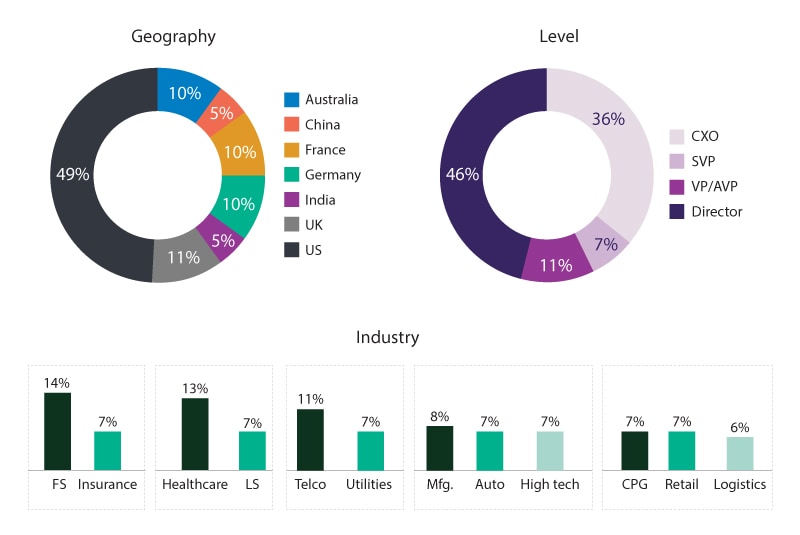The digital transformation journey
Retailers have relied on sales data, demographics and other basic information to steer business decisions, from stocking shelves to locating new stores. But this approach became outdated as Amazon evolved from online bookseller to the world’s most valuable publicly-traded company.
The volume of data now available – along with the exponential growth of online shopping – has forced the industry into a critical transition. Physical retailers must reinvent themselves to take a larger share of the digital market. These challenges call for a new harmonized retail reality: Companies now must decide how to seamlessly balance online and physical sales, and effectively utilize customer data.
But traditional retailers are not just contending with Amazon. Technologically-advanced legacy retailers along with emerging online sellers are pressuring the rest of the industry to innovate quickly just to survive.
In early 2018, Infosys surveyed more than 1,000 senior management level executives working in large organizations around the world with more than 5,000 employees and over $1 billion in annual revenue. That research on digital evolution included responses from dozens of retail industry executives.
Based on that survey, we produced a report — Infosys Survey Report — showing that incumbent organizations (as opposed to digital natives) fall into three clusters determined by their progress along the digital transformation journey:
Knowing that many organizations are rapidly intensifying their digital transformation efforts, Infosys conducted a new survey in November 2018 to gauge the pace of that change. This new research shows that the percentage of retail watchers and visionaries increased among survey respondents, while the percentage of explorers decreased. Companies generally told us that advancing from the watcher to the explorer level doesn’t require herculean effort, but reaching the visionary level is significantly more difficult.
Pressure on the retail sector is increasing as familiar brands file for bankruptcy, and announced store closures surpass previous year’s U.S. and U.K. totals, according to Coresight Research. However, 54% of retailers are optimistic about opening new stores, according to a 2019 study by Forrester and the National Retail Federation. This annual study of top companies suggests that the industry won’t implode or suffer a “retail apocalypse.” But at the same time, it highlighted the need for retailers to go deeper into their personalization efforts. Both online retailers and visionary legacy organizations are poised to seize market share from competitors that fall behind.
Fewer explorers, more watchers and visionaries
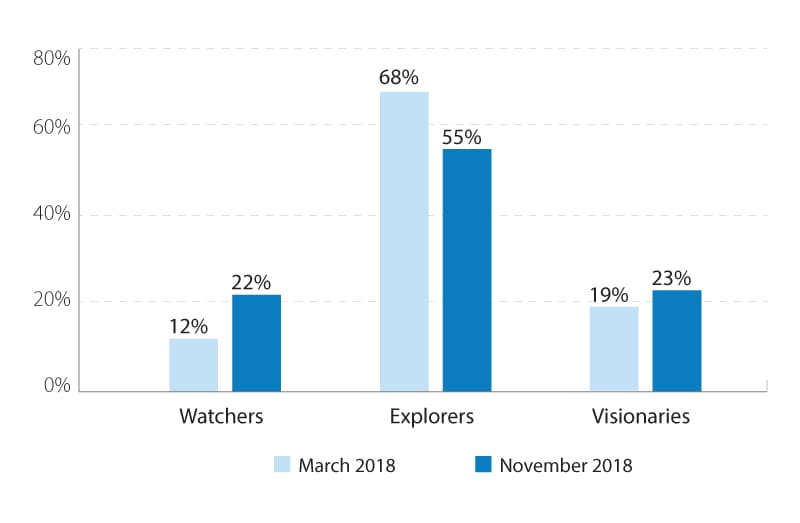
The need to be visionaries
Almost every incumbent retail firm is being pushed by disruptors or peers to digitally transform, from balancing online and in-store sales to deciphering consumer behavior. Many companies will only survive if they become digital transformation visionaries.
Some incumbents unable to keep up with the pace of technological change have already succumbed to competitive pressures. Many more in the retail industry will likely fall by the wayside. 2017 already set a record for U.S. retail store closures, while a record square footage was shuttered in 2018. To avoid being blindsided by competitors and stay relevant, companies must find ways to transform their products, processes and business models using digitally-enabled approaches and technologies.
Navigating the transformation journey
Our most recent study takes a closer look at the transformation journey. We identified 22 key digital initiatives and then asked respondents where their companies stood on implementing each initiative:
- Not started (or in planning).
- Completed multiple proofs of concept.
- Completed pilot projects.
- Operating at scale.
We then developed the Digital Maturity Index and assigned each company an index score from 0 to 100 according to its progress on pursuing and implementing the 22 key initiatives.
Companies on the digital journey
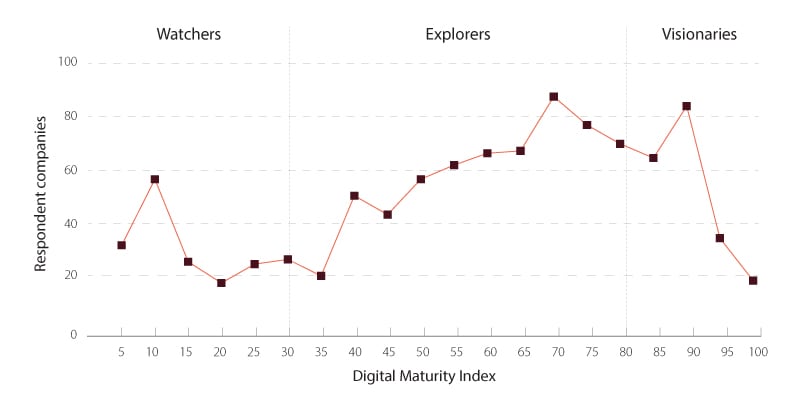
Comparing clusters on their digital transformation journeys
As retail companies advance through the digital transformation journey from watchers to explorers to visionaries, they operate more and more key digital initiatives at scale. The types of projects change throughout the journey and can be grouped into four categories:
- Foundation initiatives must be implemented to modernize legacy systems.
- Mainstay initiatives represent the core elements of digital transformation, including automation and artificial intelligence (AI).
- Customer initiatives primarily impact the customer experience. They include omnichannel marketing and content personalization.
- Forefront initiatives harness cutting-edge technologies, such as augmented reality (AR), drones and blockchain.
Visionaries stand out – cluster progress across 22 digital initiatives
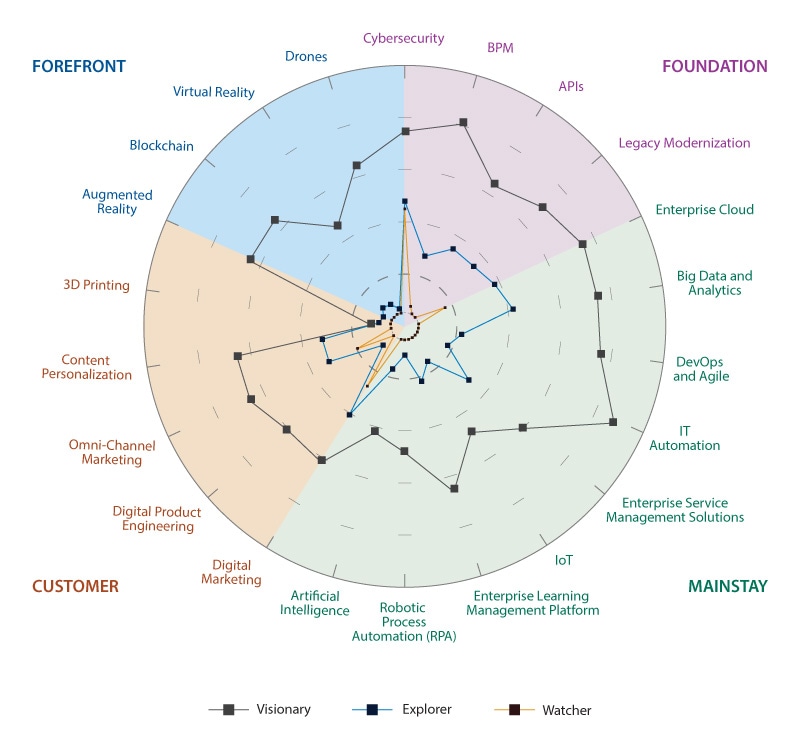
As shown in the previous figure, retail visionaries are significantly more advanced than explorers in their implementation of almost all initiatives, and watchers are far behind.
| Watchers | Explorers | Visionaries |
|---|---|---|
|
|
|
Changing focus, making progress
Visionaries have many more initiatives operating at scale
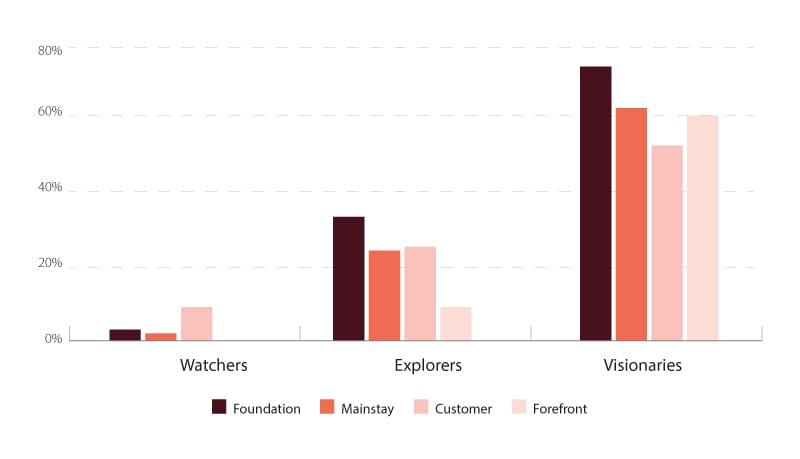
As retail companies advance along their digital transformation journey, they tend to focus on different sorts of projects. Watchers are just trying to build a foundation for their digital transformation, so they are unlikely to have the bandwidth to launch mainstay, customer or forefront initiatives.
As companies reach the explorer stage, they turn their attention to a broader range of initiatives, including such mainstay ones as big data and analytics, RPA and enterprise cloud. For most retailers, big data is seen as a valuable resource to forecast demand and also personalize the shopping experience, a strength of online retailers. They can also spend time working on customer initiatives such as content personalization, digital product engineering and digital marketing. However, explorers must still invest time focusing on the basics, such as scaling the implementation of core foundational initiatives such as legacy modernization, application programming interfaces (APIs) and business process management (BPM).
Retail visionaries bring many initiatives to scale in the foundation, mainstay and customer categories. On forefront initiatives, they are also the only cluster making substantial progress on scaling blockchain technology and 3D printing, which is already offered as an online service by Amazon, Staples and others.
Shifting barriers on the digital transformation journey
Our survey revealed that an inability to experiment quickly is the greatest barrier to digital transformation that retail companies faced in 2018. Fewer than half of respondents (45%) worry that their companies lack the capacity for rapid experimentation that is essential for testing different technologies and figuring out which ones hold the most promise.
Most companies believe that they can quickly develop this capability. Only 19% of respondents in the retail industry felt that lack of rapid experimentation skills would still frustrate their digital transformation in 2019.
Barriers to digital transformation
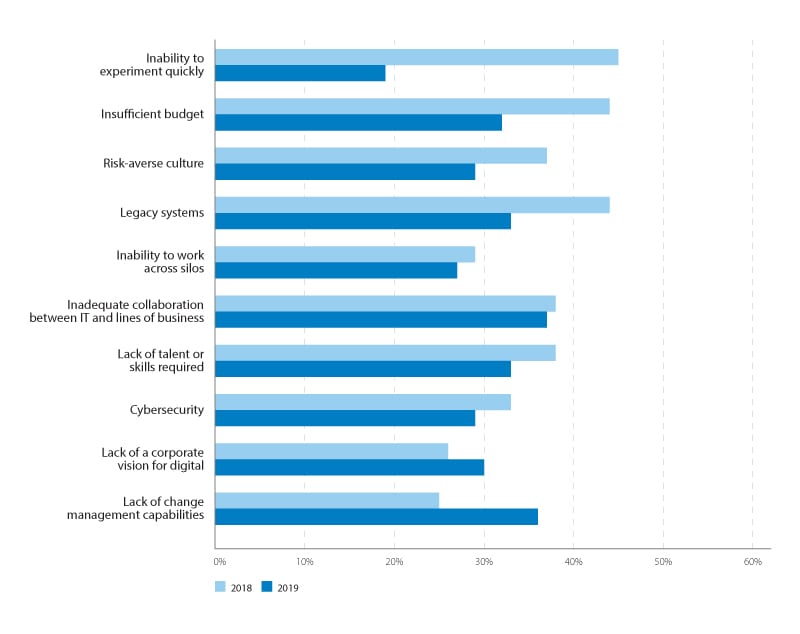
Retailers struggle with omnichannel execution, and their success in cross-channel fulfillment hasn’t taken off in a big way. Only a few visionary retailers, such as Best Buy, are making substantial investments in “buy online, pick up in-store” promotional strategies. Currently, operations and personnel are not aligned for fulfillment success, with inventory visibility a challenge to forecast cross-channel demand. Inability to forecast and tap into customer behavior has derailed personalization efforts across customer touchpoints. Retailers must invest in Agile processes and workflows to scale faster.
We believe that retail companies underestimate the challenge of mastering the art of rapid experimentation. Companies need to implement major cultural changes to become adept at rapid experimentation, according to Alok Uniyal, vice president and head of Agile and DevOps at Infosys. Significant cultural shifts rarely happen quickly.
While respondents feel that most barriers to digital transformation will diminish over time, they have persistent concerns over legacy systems.
Although retail company executives expected legacy systems would improve this year, it was still the third most commonly cited barrier (named by 33% of respondents).
Indeed, digital natives cite their lack of legacy systems as a major competitive advantage.
Experience with digital transformation is a double-edged sword. On the one hand, the visionaries who have progressed the furthest along the digital transformation journey recognize the most barriers, identifying more than four from the list of 10 that we provided.
At the same time, retail visionaries are also more optimistic than their counterparts in the watcher and explorer groups about overcoming these barriers. This demonstrates that companies become more confident as they gain experience with implementing successful pilots and bringing ideas to scale on their digital transformation journey.
Survey respondents are also confident that budgetary constraints will become less of a barrier in 2019. While 44% of retail industry executives cite “insufficient budget” as a barrier to digital transformation in 2018, 32% feel that it will still be a serious stumbling block this year. That’s still high enough to make it one of the most significant barriers. If organizations devote more investment to key digital initiatives, that would show that senior leaders are strengthening their commitment to digital transformation.
There are signs that retailers are investing in their future. Retail IT spending was estimated at $197 billion in 2018. That’s expected to increase to more than $225 billion by 2022, according to Gartner.
On the flip side, participants expect that change management will only grow harder as time goes on. While 25% of respondents named “lack of change management capabilities” as a barrier in 2018, 36% said it would be a problem in 2019 for the retail industry. Watchers and explorers are especially worried about managing change.
Digital maturity by industry
Our survey revealed significant differences in digital maturity by industry. We found that technology, manufacturing, telco and financial services companies had progressed furthest on their digital transformation journeys. Digital Maturity Index scores were distinctly lower in other industries such as consumer goods, logistics and health care.
Compared to other industries, retail is in the middle of the pack on digital transformation maturity. Even though the retail industry has been ravaged by digital disruption, many legacy retailers have not made much headway on their digital transformation journeys.
That said, some legacy retailers have taken bold steps into a digital transformation future. Supermarket News reported that Walmart has begun experimenting with having robots expedite fulfilment of online grocery orders and using autonomous vehicles to transport grocery customers between their homes and the store. “Walmart is just as innovative as Amazon, for the population they serve, the number of things they try, and the strategies they take,” said Corey Glickman, leader of strategic design consulting at Infosys.
Industry ranking on the Digital Maturity Index
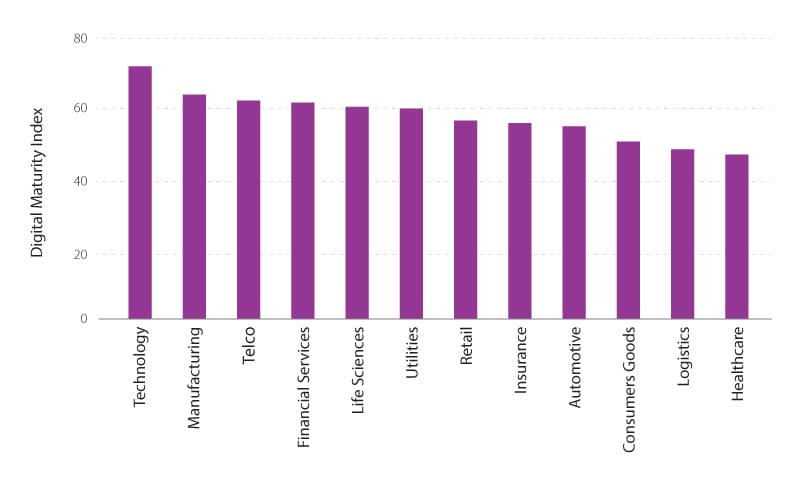
Accelerating the digital transformation journey: 5 key capabilities
In August 2018, Infosys conducted a research study that identified five capabilities that help companies, including those in the retail industry, accelerate their digital transformation journeys: Agile and DevOps, automation and AI, design, learning, and proximity.
In our November 2018 executive survey, we looked deeper to understand company competencies in these areas. We found that companies with the highest Digital Maturity Index scores (i.e., the visionaries) do indeed have the strongest abilities in all accelerator categories.
Visionary companies have superior accelerator capabilities
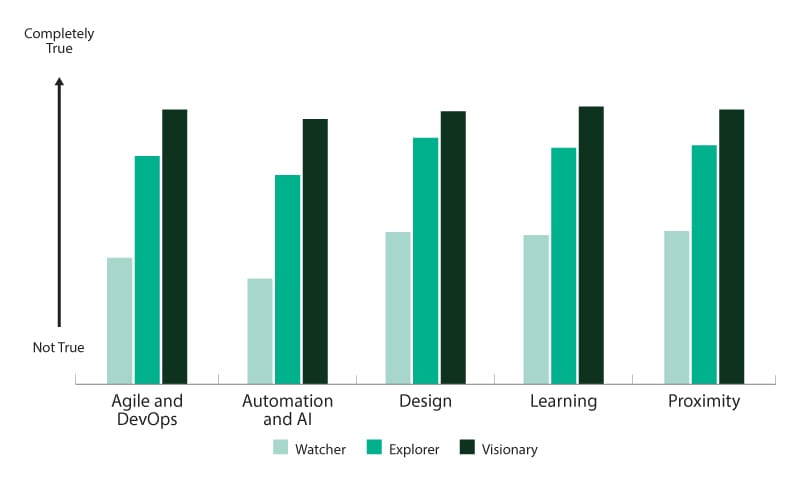
Cluster average
The five digital capability accelerators above are each powerful in their own right, and we examine each of them on the pages that follow. Before looking at the accelerators individually, it is worth reviewing them holistically at a summary level. When we reviewed client and industry digital transformation programs, we found multiple successes in the past two years where one of the accelerators was dominant. However, in discussions with executives about the next 12 months and beyond, the consistent message was that multiple accelerators will increasingly be needed for future success. Agile and DevOps programs will be required for the uncertainty that accompanies the frenetic ongoing pace of change. The amplification and intelligence from automation and AI will be required to make sense of an increasingly complex world.
Design will become a non-negotiable expectation that goes beyond functionality to experience, and will permeate more and more business functions.
The rate of change faced by enterprises, and the necessity for widespread adoption, virtually guarantee that learning will be a core part of any lasting transformation. Finally, the location or proximity to work will be a major factor in capability and program planning, both for strategic intent and cost management.
Let’s examine each of these digital capability accelerators.
Digital transformation accelerator No. 1: Agile and DevOps
“There’s an overarching need for companies to be nimble and responsive, to understand company needs, and quickly develop solutions,” said Uniyal, the Infosys Agile leader.
“Agile and DevOps enable companies to beat competitors by quickly experimenting, validating ideas and scaling leading-edge solutions. They enable greater flexibility and higher productivity. DevOps helps by automating the Agile software development lifecycle, enabling companies to deploy new features on a nearly continuous basis.”
Retail giant Target created immersive, six-week sessions – called “the Dojo” – where technology teams were supervised by Agile coaches, company chief information officer Mike McNamara told The Enterprisers Project. “The Dojo has been fantastic in getting teams engaged with Agile and DevOps, removing the natural resistance and fear of change,” McNamara said.
The visionary retail companies that are furthest along the digital transformation journey have the strongest ability to deliver Agile programs at scale. They have fully adopted both an Agile mindset and Agile practices. Their IT developers and operations teams cooperate closely to achieve business objectives.
Their technology teams deliver results fast enough for these legacy companies to stay competitive and fend off digital native rivals. Such visionaries are also likely to have a robust, stable DevOps platform that serves their entire enterprise.
There are two primary barriers that prevent retail firms from making more progress on Agile and DevOps.
One major organizational challenge is changing the culture to ensure that business cooperates with IT from the start.
Our research has found that about 80% of development projects are IT-led and IT-sponsored, without early involvement of business stakeholders.
If companies can change their culture and mindset to ensure early business and IT collaboration, they will dramatically improve likelihood of Agile and DevOps success.
In addition to cultural change, retail companies also need to make sure that their employees are trained in new ways of working. This retraining must extend throughout the organization so that all stakeholders have a good understanding of these new ways of working.
Agile and DevOps methods can be extremely useful in certain industries such as branded consumer goods where speed is critical to successfully keep pace with fast-changing trends. In other industries, such as banking and airlines, there are regulations, risk and audit controls that can impede efforts to scale up Agile and DevOps.
While our survey shows that many companies are confident — perhaps overconfident — in their ability to master rapid experimentation, the reality is that Agile and DevOps techniques are hard to master. Even companies that purport to have flexible, Agile teams may still rely on the same old structured, rigid waterfall development methods inside those teams.
There are practical steps that companies can take to improve their Agile and DevOps skills. Companies can work faster and scale quicker while meeting the demands of global markets by implementing Agile on a distributed basis.
“Companies need to become more dynamic and nimbler,” Uniyal said. “To react faster to changing markets and come up with improved products and services, companies need to have a culture of rapid experimentation, quick development, prototyping and validation. To accomplish this, they need to be able to visualize their end-to-end value chain. This is a major challenge in legacy organizations where the value chain may be fragmented. The best way to overcome this issue is by implementing Lean.”
Digital transformation accelerator No. 2: automation and AI
AI and automation have the potential to radically transform existing business models and unlock new opportunities in the retail industry. While Amazon is using AI to create its cashier-free Amazon Go stores, Walmart harnessed the technology to manage the restocking of shelves at its Intelligent Retail Lab concept store. And Microsoft and Kroger are also planning their own AI-powered pilot stores. Meanwhile, one U.S. convenience store chain used AI to help identify new store locations.
What distinguishes visionaries from their peers when it comes to AI and automation? Our survey found that visionaries are more likely to have developed and started to implement well-articulated strategies and initiatives for AI, RPA and IT automation. They also tend to approach automation and AI as ways to amplify human capabilities rather than just reduce headcount and costs. Their employees have the skills to implement automation and AI technologies in ways that advance corporate strategic goals.
That said, retail companies at all stages of their digital transformation journeys are grappling with the ethical implications and opacity of AI.
“We need a paradigm shift in how we interact with AI and automation,” said John Gikopoulos, global head of AI and Automation at Infosys. “We should apply ethics and control at the personal level, rather than expecting a process, machine, or laws to govern these technologies once they are out in the world.”
When retailers leverage technology to gain more customer insight, there is a risk of backlash about privacy violations and even accusations of “creepiness.” That perceived creepiness factor, however, appears to be easing, according to Infosys’ Retail 2025 Shopper Study, which surveyed 5,000 people. The research found that 73% of shoppers were likely to allow retailers to digitally identify them for the purposes of personalization.
Kroger and Walgreens are experimenting with cameras on shelves and cooler doors to guess a customer’s age and gender. That data is then used to deliver targeted ads or discounts, according to the Associated Press.
Other smart shelves on display at the National Retail Federation trade show this year tried to detect people’s moods, which are potentially valuable observations yet could also create pushback from consumers and privacy advocates, the AP reported.
Better tools are constantly coming to market that give the retail industry new ways to create AI applications. Companies need to figure out the best ways to harness these tools to develop useful solutions that meet client needs. To get the most benefit from automation and AI, most incumbent companies will need to convince their own workforce about the benefits of these technologies and reskill employees to make sure that people and machines can work seamlessly together to achieve superior results.
Digital transformation accelerator No. 3: design
Design skills enable companies to rethink every aspect of their business, from internal operations to external customer service. Retail companies with superior design skills use technology to find novel solutions to serve human needs.
Our survey shows that companies with design strengths are better able to seize opportunities to improve both customer and employee experiences. They are more likely to deploy technology in the form of digital product engineering, content personalization and AR.
Beauty retailer Sephora harnessed AR and AI to allow customers to virtually test different types and shades of makeup. Millions have used the Sephora Virtual Artist app to evaluate the company’s thousands of products.
Retail visionaries understand that design is more than mere user experience. Instead of segregating user design within its own silo, they make sure that more people, in more functions across the company have responsibility to design products and services that maximize user satisfaction.
Design-led retail companies have effective processes in place to continuously listen to customers. They are committed to testing ideas and iterating to make those ideas better over time. They measure design performance and results with the same rigor that they apply to tracking revenues and costs.
When it comes to pursuing design-led solutions, Glickman warned against excessive prototyping. He said too many companies spend millions of dollars a year on prototypes and proofs of concept, without ever moving on to implement those pilots at scale. In times of disruptive change, companies must bite the bullet and make big bets. It sometimes takes an industry leader or innovative upstart to establish a new norm. “No one would have a digital twin today if GE hadn’t sunk millions of dollars into developing theirs,” Glickman pointed out.
Systems engineering has emerged as a critical role in the digital age. The best systems designers are diligent scientists with master’s degrees and many years of work experience. This type of talent is in short supply, exacerbating the war for talent. However, the good news is that a systems designer with experience in one area can typically apply his or her knowledge to other domains. “Systems designers understand how large, complex systems behave,” Glickman said.
“As a discipline, systems design is universal enough that someone with experience in financial services can apply their skills and experience to software design or health care.”
On a practical, operational level, our research has confirmed the effectiveness of breaking up large projects into small teams of highly-skilled programmers handling the hardest and most important challenges. These all-star coders are hands-on, working iteratively in physical and virtual whiteboard environments, efficiently pulling from reusable code libraries and writing their own fresh code every day. This approach can reduce development time from three months to as little as three weeks. With this arrangement, companies can deliver more effective programming, solve difficult problems faster, and reduce technical debt that may have accumulated through legacy programming and processes.
Finally, the success of design-led digital transformation depends on the involvement of senior executives. Design is helping to transform major components of enterprise operating models, and success requires buy-in and leadership from the top.
Digital transformation accelerator No. 4: learning
The biggest challenges for retailers are shortages of talent and skills, according to Infosys research. Untrained store associates who aren’t able to engage with customers cannot improve a store’s operational efficiency and create deeper customer bonds.
Retail visionaries were particularly concerned about increased productivity, with 82% saying that was a major business objective of their digital transformations. Slightly more than half of watchers and explorers listed that as a main factor.
Companies are facing a significant gap between the digital skill sets they need and the talent available, according to Jonquil Hackenberg, partner at Infosys Consulting. “Recent graduates, even in desirable fields like data science and enterprise architecture, lack the experience and expertise to implement at scale,” warned Hackenberg. “Meanwhile, many legacy IT professionals struggle to engage with subject matter experts in a way that translates business needs to modern, scalable technology solutions.”
Visionaries in the retail industry are more likely than other firms to bridge this talent gap by investing in the digital tools and infrastructure necessary to support a robust, always-on, continuous learning and reskilling program for employees.
Continuous learning is fundamental to developing the workforce of the future, one that can achieve and sustain digital transformation. Employees must become nimble, responsive and proactive enough to identify and seize the best opportunities made possible by emerging technologies and new business models. Our research findings suggest that such continuous learning programs play an especially important role to help employees develop skills in Agile and DevOps, areas that are as much mindset shifts as technical skills.
Employees realize the critical importance of continuous learning to keep themselves marketable and relevant in a rapidly changing business world. Beyond internal skills development, learning programs have the added benefit of supporting retention. Employees appreciate when companies make investments in their career development.
Many leading retail companies have built their own internal training, reskilling and upskilling programs.
Our research shows that watchers often overlook the substantial benefits of learning accelerators.
For companies looking to make the move from watcher to explorer, investing in learning is an important early step.
Digital transformation accelerator No. 5: proximity
Even though many retail companies are competing in a global marketplace and have access to a growing suite of collaboration and communication tools, distance still adds complications to any initiative or project. On the other hand, proximity enhances collaboration and can remove physical barriers to success in product and IT development projects.
“Value creation occurs when companies bring teams together end-to-end in proximity,” advised Deverre Lierman, leader of the Infosys Raleigh Technology Hub.
“Companies should deliberately structure their ecosystem and choose their partners with an eye to maximize innovation, speed and responsiveness. The key is to capitalize on the benefits of high-quality, low-cost locations without sacrificing the advantages that proximity brings. Visionaries balance global delivery centers with nearby innovation hubs.”
These hubs may be internal or involve strategic partners. Century-old luxury retailer Neiman Marcus operates an innovation hub (iLab) that often collaborates with third parties. Despite its small staff, the lab managed to create the “Memory Mirror,” an inventive digital tool that allows customers to record themselves from different angles and replay the footage.
“As our world has increasingly become more digital, [iLab has] helped us remain cutting-edge,” said Scott Emmons, head of iLab, in an interview with CMO.com. “IT now has a seat at the table of the ideation process and is part of the discussions that get tech launched. That means we’re in a position to say yes and deliver what the customer wants more easily.”
Our data shows that visionaries are more likely than watchers or explorers to have implemented finely- tuned strategies to locate employees together in geographies that balance cost with proximity to partners and customers.
Still, even visionary retail companies depend on the contributions and efficiency of distributed development teams. Visionaries supply these teams with effective collaboration tools and implement standards to measure the quality of work these distributed teams deliver. To the extent that visionaries rely on global development centers, they also invest in the infrastructure and systems to minimize the impact of distance.
At the same time, visionaries recognize that there is no substitute for physical proximity and are quite willing to establish well-staffed technology and innovation hubs near important partners or customers. That is why Infosys is establishing six new technology and innovation hubs in the United States and staffing them with 10,000 American employees to serve its customers there. Such proximity is especially valuable when working on initiatives involving customer experience, such as product development, content personalization and AR.
Companies looking to reap maximum benefits from proximity should locate their technology and innovation hubs near end users (i.e., clients) and in places that have intrinsic appeal for the talent that the company wishes to recruit and retain. Locations near top universities are also attractive, since those schools can provide a pipeline of candidates for recruitment and an ecosystem for incubating innovation ideas.
Retail companies at all stages of digital transformation should strive to create a culture that attracts talent. Our research shows that employees want to work in a collaborative and collegial environment, where they know they can focus on getting results without wasting time fighting turf wars.
Practices and mindset — what sets visionaries apart
Every incumbent retail company knows that it needs to make progress on its digital journey, but our recent survey indicates most are not moving fast enough.
How can they move to the visionary level? What sets visionaries apart from watchers and explorers?
According to our research, visionaries stand out in the way they have fully embraced the mindset and practices of both being agile and doing Agile.
To become more like visionaries, retail companies should put in place a formal digital transformation strategy, and share that plan with employees, customers and partners alike. They should also develop and implement a comprehensive strategy for using automation and AI to bolster human capabilities, rather than just focusing on cutting costs.
These are not trivial matters. Companies will face real challenges around talent recruitment and reskilling, retooling legacy systems, building the five accelerator capabilities and fighting off lean, hungry digital native disruptors.
Even fast fashion pioneer Zara is being pushed by more agile online-only competitors. Some of those new retailers are able to turn around designs in as little as a week.
The truth is that incumbent retail companies need to do three things, do them all well, and do them simultaneously:
- Establish the technical foundations for digital transformation.
- Build technological capabilities and talent.
- Innovate at the speed of Agile.
There are two ways that companies can give themselves a boost on the digital transformation path.
They can seek to amplify their existing capabilities by focusing on high-value projects with the greatest potential impact, and they can partner with other organizations to gain access to complementary skills and resources.
Amplify
Retail companies have limited talent resources, so it makes sense to focus systems designers’ efforts on the biggest problems where the solutions they create will have the greatest impact. “You can amplify the impact of designers by assigning them to small teams where they can work together to deliver scalable solutions that can be replicated throughout the organization,” explained Infosys’ Glickman.
“If you have the right systems and process, a small number of talented individuals can have a big impact on a company’s digital transformation journey.”
The retail industry needs to figure out which projects to prioritize and how to push the digital envelope where it will matter most. Visionaries are comfortable with different parts of the organization being at different steps in their digital transformation journeys.
Partner
Retail industry executives told us that only about a third of digital initiatives are led and delivered internally; nearly half are led internally and delivered by partners, while the remaining one-fifth are fully delegated.
Companies partner for about two-thirds of their digital initiatives
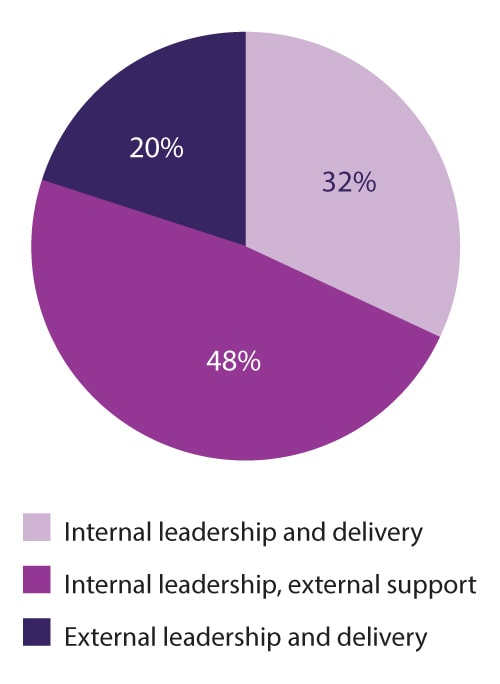
There is a significant difference in how clusters handle partnering in the retail industry. Watchers are the most likely to run initiatives entirely internally. Explorers are most likely to lead projects internally, while having them executed externally. Visionaries are usually more likely than the others to let partners run and deliver initiatives on their behalf. Among the retail respondents, however, watchers had a slightly higher percentage of digital initiatives delivered externally.
Explorers are more likely to partner on digital initiatives
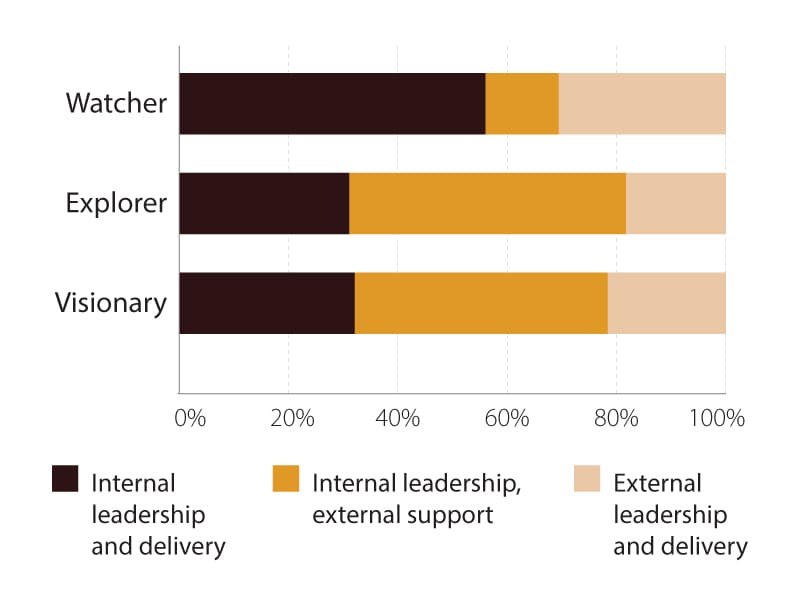
According to our respondents, partnering offers two primary advantages: higher chances of success and quicker implementation.
Partnerships have several advantages
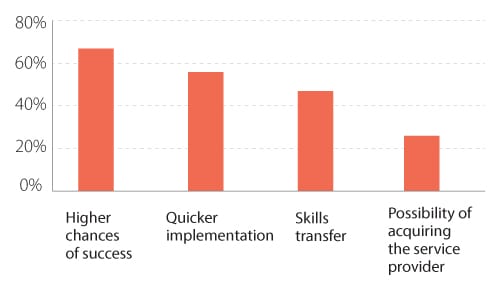
According to our research, visionaries are more likely to form partnerships because they have the process and governance maturity needed to build and run them effectively. It’s the same reason companies that invest in architecture and data management are more likely to support API interfaces with external services. Visionaries also have experience building partnerships and understand the multi-faceted value of a good partnership, so they are more likely to pursue and forge additional partnerships when opportunities arise.
The digital accomplishments of retail industry visionaries also give them a better appreciation for the unique capabilities that partners bring to the table. When it comes to the vast world of technology, visionaries who develop certain technical skills also tend to learn that they cannot be experts at everything. Instead, they recognize the value of focusing on their core competencies and gaining access to other expertise through mutually-beneficial partnerships.
Respondents told us the best partnerships are built on strong personal relationships among humans.
Innovative partnerships can spur the next level of collaboration to scale a retailer’s digital initiatives. The valuable partnership between Starbucks and Spotify accelerated downloads of the Starbucks’ app and use of its loyalty program. Amazon and Best Buy also jointly launched Amazon’s new Fire TV edition, a win-win situation that created synergies and leveraged strengths through the partnership.
Our survey showed that retail companies are willing to partner on almost any digital transformation initiative, but they are least likely to work with partners on legacy modernization, where they presumably feel they have the in-house knowledge to upgrade those systems on their own.
Survey participants reported that their companies were most likely to ask an external partner to both lead and deliver on sophisticated initiatives like RPA, drones, content personalization and IT automation. More than one-fourth of incumbent retail companies turn to partners for help with these sorts of initiatives that require specialized, hard-to-recruit expertise.
Retail companies were more apt to favor internal leadership, while partnering with external help for execution on initiatives such as DevOps and Agile, internet of things, AR and APIs. These areas also require specialized expertise and significant resources, but in-house staff may already have some experience in these fields and thus feel more confident directing such projects themselves.
According to our research, U.S.-based companies tend to view intellectual property (IP) even more as a proprietary advantage than their European and Asian counterparts. As a result, U.S.-based firms more often prefer to develop high-value innovation in-house. European firms partner for IP in a more transactional manner, while Asian companies have shown more openness for partners to take leading roles in IP creation.
Accelerating the journey
As mentioned in the Amplify section above, every retail company—including visionaries—needs to prioritize specific digital transformation projects in order to maximize the impact of scarce resources. Complexity and fragmentation are barriers that hold back the retail industry from achieving the agility needed to scale up digital transformation initiatives, such as embedding AI and machine learning (ML) into core processes.
Even online retailers have struggled with the changing customer landscape. They’ve been unable to solve the problem of cart abandonment, which is estimated at 70%, according to the Baymard Institute.
How can a company know which projects to prioritize?
- Analyze its level of digital maturity and develop a clear, honest evaluation of current initiatives relative to objectives.
- Assess the short-term future of its industry. What are the key threats from disruptors? Which emerging technologies hold the most promise? How are customer expectations changing? What impact will these factors have on business models?
- Ensure that the company has a solid digital foundation by modernizing legacy systems and working on APIs and BPM. Strength in these areas will enable success in other aspects of a digital transformation plan.
- Strengthen and refine the five accelerator capabilities - Agile and DevOps, automation and AI, design, learning, and proximity.
- Forge relationships with partners whose skills and services could promote faster, better progress toward digital transformation goals.
As with other change initiatives, senior retail executives should take an active role in driving digital transformation initiatives.
Retail industry leaders have to send a signal that such internal power struggles will not be tolerated. Digital transformation journeys can only succeed when individuals from multiple areas of the organization step outside their comfort zones and work across boundaries for the good of the entire enterprise.
The digital future is arriving at a rapid pace, and the consequences of inaction are more severe than ever. With proper planning, cooperation and commitment, business leaders and IT professionals can work together to position their companies for success, no matter which direction the digital winds may blow.
Survey methodology
In November 2018 the Infosys Knowledge Institute used a blind format to conduct an online survey that attracted responses from more than 1,000 CXOs and other senior-level respondents from companies with revenue upward of $1 billion. Respondents represented multiple industries and hailed from Australia, China, France, Germany, India, the U.K. and the U.S.
To gain additional qualitative insights, we also conducted phone interviews with more than a dozen industry practitioners and subject matter experts.
Survey coverage
